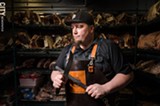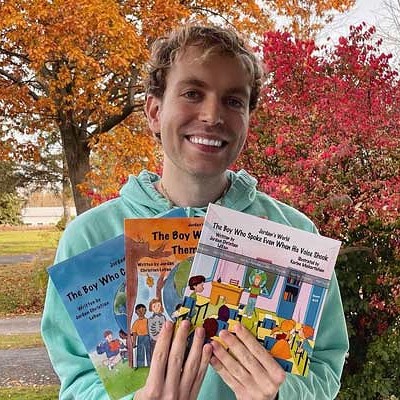[
{
"name": "500x250 Ad",
"insertPoint": "5",
"component": "15667920",
"parentWrapperClass": "",
"requiredCountToDisplay": "1"
}
]
The hanger steak might be the perfect symbol for the struggles of the local meat industry.
It's not as common as porterhouses or strip steaks, but for those in the know, the hanger steak is a flavorful option at a more modest price. But it's a single, one-pound-or-so muscle from an animal that provides more than a quarter ton of meat. So what happens to the rest of the animal?
This is local meat's dilemma: supply and demand don't always match up. Restaurants want familiar or prized cuts of meat, but chefs won't get that meat from nearby farmers unless they're assured of an adequate supply. And local farmers who do supply key cuts to restaurants often have to find buyers for the rest of the beef or pork from their animals.
But Kevin and Yeonmo McCann, owners of McCann's Local Meats, and the people at Headwater Food Hub see an opportunity to address both ends of the problem. The businesses are partnering on a new cutting and processing facility which should bring local meat, starting with beef and pork, into more restaurants and institutions.
The facility will also give small- and medium-sized farmers a central entity that they can sell their slaughtered animals to (the facility won't have a kill floor). The operation will market the meat to restaurants and custom butcher it for them, too.
"To me, this is an example of food system development that is looking to the future and is looking toward sustainability," says Chris Hartman, Headwater's president.
The McCanns will manage the operation, which will be located on Headwater's campus just east of Webster in Ontario, Wayne County. Headwater will distribute the meats through its existing wholesale network.
All of the meat will come from pastured animals and from farms that use humane practices.
"The farmers that we're going to draw from definitely have the ability to keep up with our quantity, especially right off the bat," McCann says. "In a lot of ways, hopefully that gives us the opportunity to scale up with each other."
New York has been more of a dairy state than a meat state, though the numbers have shifted some. Statewide, farmers had 75,000 beef cattle in 1990 and currently have around 110,000, says Mike Baker, beef cattle Extension specialist for Cornell University's animal sciences department. There are 625,000 dairy cattle in New York.
New York doesn't have the high-capacity slaughterhouses that have developed in the Midwest, often due to consolidation within the meat industry. The state's slaughtering, cutting, and packing facilities are generally smaller and geared toward farmers who want the meat divided into marketable cuts.
The Finger Lakes region has several such shops, but they are often inundated with work, says Stefan Schwartz, Headwater's purchasing director. Some shops are booked up a year in advance, he says.
The McCann-Headwater facility is intended to provide relief to the bottleneck in the meat flow. McCann says that the facility is being planned with the objective of processing 30 beef cows and 90 hogs a week.
McCann's Local Meats opened just after Memorial Day last year, and its owners set out to clue in local retail customers and select chefs to new cuts of meat. It's an approach borne out of a deeper philosophy.
"On a retail level, the reason that I make as many different styles of product as I do is because it helps to fully utilize each animal as evenly as possible," Kevin McCann says. "But the wholesale market is going to be a completely different — pun intended — animal."
The McCanns and Headwater say that they want to translate that approach to restaurant and institutional customers. The McCanns are trained and experienced chefs, and they plan to draw on that background as they help area restaurants find the cuts they want, and as they work to introduce them to some of the unfamiliar cuts.
A Denver or ranch steak cooks and eats similar to a strip steak, McCann says. And a cross-cut beef flank can make a good substitute for veal shank in the Italian dish osso buco, he says.
The partners say that if they can build up interest in a greater variety of cuts among restaurants, chefs, and diners, it will increase the amount of local meat available. And if restaurants buy those cuts, farmers will get more value out of each animal.
"Restaurants and chefs as a whole, chefs want to use the best ingredients that they can find," McCann says. "They want to use local ingredients and have been for a number of years, it's just that the protein is the difficult nut to crack with that."
Speaking of...
-

Webster girds for civic battle over proposed lettuce farm
Nov 5, 2019 -

Fear of missing the dish
Jun 20, 2018 -

Finger Lakes region gets state funding for projects
Dec 13, 2017 - More »
Latest in News
More by Jeremy Moule
-

ROCHESTER TEN
ANNETTE RAMOSAug 1, 2023 - More »





